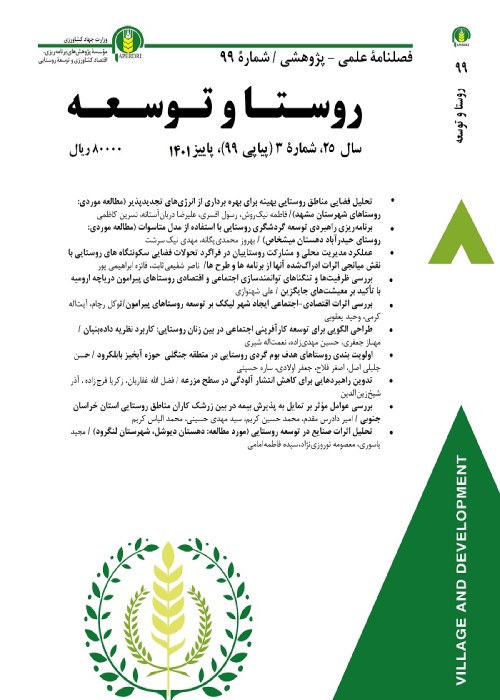Drivers of Recognizing Entrepreneurial Opportunities for Rural Woman Entrepreneurs in Agricultural Sector of Ilam Province
Considering capabilities including good weather conditions, four types of climate, raining, and fertile soil, Ilam province has many entrepreneurship potentials and opportunities in agricultural sector. It is obvious that recognizing entrepreneurial opportunities in agricultural sector and reducing unemployment rate are of high importance in such conditions. Despite the significance of this issue, researchers have not paid much attention to recognition of women’s entrepreneurship opportunities. Considering that entrepreneurship is a capacity to discover and utilize profitable opportunities in a competitive market, a low level of understanding and recognition of entrepreneurship opportunities by Iranian entrepreneurs is notable. Accordingly, it can be inferred that not recognizing existent potentials and opportunities in the agricultural sector for women is the main reason for the low rate of employment among women, thus improving capabilities to recognize entrepreneurial opportunities among job seekers is one of the best solutions to resolve unemployment and to develop entrepreneurship.
The current study is a practical interpretive research. In terms of method, it is a qualitative research in which an inductive approach has been utilized. Semi-structured interviews and thematic analysis were utilized to analyze the data and the used texts, respectively. Semi-structured interview by an exploratory approach was utilized to achieve the goals of the qualitative research and to extract indicators related to recognition of entrepreneurial opportunities. Five selected female entrepreneurs in 2019, 6 professors in entrepreneurship field who were familiar with agricultural sector's concerns, and 6 employees in Agricultural Jahad Organizations with more than 15 years of service, were interviewed using a semi-structured interview. Non-probability and purposive sampling using a snowball sampling approach was utilized to select the sample. Selecting the sample was continued to ensure sufficiency and saturation of the data and to ensure that the next samples do not provide different information. In this study, 17 participants were interviewed. Lincoln and Guba’s evaluation was utilized to investigate the reliability and validity of the coding stage in analyzing qualitative context.
Qualitative analysis of field interviews and their implementation and coding showed that among the main themes of recognition of entrepreneurial opportunities for rural women, “psychological features” by 77 frequencies were the main themes. This main theme includes some secondary themes such as creativity, independence, the need for cognition, self-efficacy in recognizing entrepreneurial opportunities, and the ability to understand and organize information. Alertness with a frequency of 62 was the second main theme. This includes primary knowledge, social networks, evaluation of information, and connecting new information and primary knowledge. “Entrepreneurial intelligence” by frequency of 60 was the 3rd main theme. It includes secondary themes such as entrepreneurial insight, cognitive intelligence, social intelligence, venture intelligence, and provocative intelligence. The 4th main theme was “environmental supports” with a frequency of 47. It includes financial, social, cultural, and political support. The 5th theme was “ human capital” with a frequency of 33. This theme includes cognitive knowledge and experience. “Social capital” which includes connected philanthropy was the 6th theme with a frequency of 29. Turbulence as the 7th main theme by frequency of 27 includes secondary themes such as factors related to environment and personality factors.
Analyzing information and the interviews showed that the main drivers for recognition of entrepreneurial opportunities can be categorized into seven categories ( social capital, human capital, psychological features, turbulence, entrepreneurial intelligence, alertness, and environmental support). Generally, in the current study, 124 initial codes, 97 conceptual codes, 25 basic ( main) themes, and 7 organizing (secondary) themes were recognized and extracted using thematic analysis of 17 interviews.
- حق عضویت دریافتی صرف حمایت از نشریات عضو و نگهداری، تکمیل و توسعه مگیران میشود.
- پرداخت حق اشتراک و دانلود مقالات اجازه بازنشر آن در سایر رسانههای چاپی و دیجیتال را به کاربر نمیدهد.




